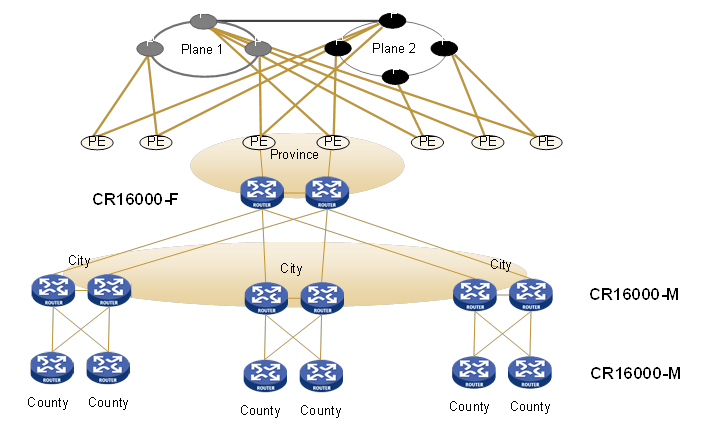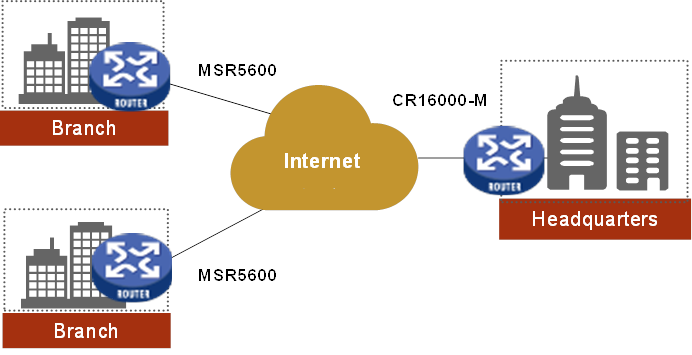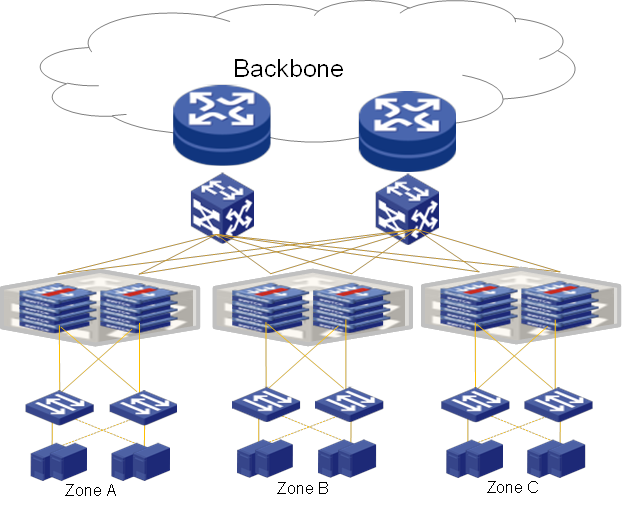Item | CR16000-M1A | CR16000-M8 | CR16000-M16 |
Switching Capacity | 640Gbps | 800Gbps | 800Gbps |
Chassis | Integrated chassis, which can be installed in a 19-inch rack |
MPUs | Fixed-port router | 2 | 2 |
Line cards | Fixed port + 1 Flexible card | 8 | 16 |
Independent switching fabric modules | Fixed-port router | 2 | 2 |
Cooling | Front-to-rear airflow | Front-to-rear airflow | Front-to-rear airflow |
Independent fan trays | Three independent fan trays in redundancy | Independent fan trays in redundancy | Independent fan trays in redundancy |
Power system | Two independent power supplies in redundancy, supporting AC/DC/HVDC | Four built-in AC and DC power modules (N+M redundancy), without occupying any service module slot. | Four built-in AC and DC power modules (N+M redundancy) , without occupying any service module slot. |
MTBF | 35 years | 35 years | 35 years |
MTTR | 0.5 hours | 0.5 hours | 0.5 hours |
Dimensions (H × W× D) | 44 × 440 × 435 mm (1.73 × 17.32 × 17.13 in, 1 RU) | 267 × 440 × 440 mm (10.51 × 17.32 × 17.32 in, 6 RU) | 356 × 440 × 440 mm (14.02 × 17.32 × 17.32 in, 8 RU) |
Ports | FE, GE, 10GE (LAN/WAN), 100GE, 155M POS, 622M POS, 2.5G POS, CPOS, ATM, and E1/T1 ports Interface type changing between 100GE and 40GE Interface type changing between 155M POS, 622M POS, and GE Interface type changing between ATM/ and POS |
Unicast routing | IPv4/IPv6 dual stack IPv4 FIB table with up to 4M entries IPv6 FIB table with up to 1M entries IPv4 Routing table with up to 25M entries IPv6 Routing table with up to 12M entries Static routing, RIP, RIPng, OSPF, OSPFv3, IS-IS, IS-ISv6, BGP, and BGP4+ VRRP and VRRPv3 IPv6 neighbor discovery, PMTU discovery, TCP6, ping IPv6, traceroute IPv6, socket IPv6, static IPv6 DNS, specified IPv6 DNS server, and TFTP IPv6 client IPv4 to IPv6 transition ICMPv6 MIB, UDP6 MIB, TCP6 MIB, and IPv6 MIB ECMP and UCMP Policy-based routing Routing policy Tunnels such as GRE Static routing FRR, OSPF FRR, ISIS FRR, and BGP FRR |
Multicast | Routing protocols, including PIM-DM, PIM-SM, PIM-SSM, MSDP, MBGP, and Anycast-RP IGMPv1/v2/v3 and IGMP snooping v1/v2/v3 PIM6-DM, PIM6-SM, and PIM6-SSM MLDv1/v2 and MLD snooping v1 Multicast policy and multicast QoS |
MPLS VPN | MPLS label distribution protocols such as LDP and RSVP-TE P/PE compliant with RFC 2547bis Three inter-AS MPLS VPN methods (option1/option2/option3) HoPE Multi-role host L2VPN, L3VPN, inter-AS L2VPN and L3VPN MPLS TE FRR and LDP FRR, with a switchover time of not more than 50ms 6PE and 6vPE Distributed multicast VPN ACL, which identifies traffic and forwards the traffic to different VPNs MPLS VPN network troubleshooting features, including MPLS ping and MPLS traceroute L2VPN access to L3VPN Access to VPLS via QinQ |
BRAS service | PPPoE, PPPoEoVLAN, and PPPoEoQ access authentication Layer 2 portal, Layer 3 portal, and QinQ portal access authentication IPoE, IPoEoVLAN, and IPoEoQ access authentication Leased access authentication such as subnet-leased, interface-leased, and L2VPN-leased access authentication L2TP Layer 2 transparent access and Layer 3 transparent access RADIUS, TACACS, and COPS protocols iTA, which differentiates services by destination addresses to perform accounting, bandwidth control, and QoS Unified wired and wireless authentication solutions, which meet the demands for massive user access and wireless client mobility BRAS IRF, which offers redundancy and simplifies Ops |
ACL | IPv4 and IPv6 ACL and EACL Ingress/Egress ACL Hardware-based ACL |
QoS | HQoS Queue scheduling mechanisms such as PQ, WFQ, and CBWFQ More granular and flexible traffic control through HQoS Traffic shaping Congestion avoidance technologies such as tail drop and WRED drop Priority marking and remarking 802.1p, TOS, DSCP, and EXP priority mappings Congestion avoidance, traffic policing, and traffic shaping Data packet marking based on IP addresses, port numbers, 802.1P, and DSCP values Data packet multilevel queue mechanisms include CQ, PQ, LLQ, and WFQ Multicast QoS |
Ethernet features | 802.1Q Ethernet Virtual Circuits ( EVC) ARP 802.1Q VLAN trunk QinQ VLAN encapsulation QinQ termination MAC address limit 802.3d (STP)/802.3w (RSTP)/802.3s (MSTP) IEEE 802.3ad (link aggregation), static link aggregation, and link aggregation across different modules Aggregation of ports with different transmission rates Port mirroring and flow mirroring FlexE Channelized sub-interfaces |
SDN technologies | VXLAN and EVPN PCEP protocol Network information collection protocols such as BGP-LS NETCONF and YANG MPLS SR and SRv6 CBTS OpenFlow BGP FlowSpec Telemetry 5G bearer network technologies such as EVPN, SRv6, and 1588v2 |
Traffic analysis | NetStream, which supports the version 5, version 7, and version 9 data export formats, sampling, and flow statistics Multi-log host Hardware-based NTA IPv4/IPv6/MPLS traffic collection and analysis Traffic collection and analysis in the inbound and outbound directions of interfaces Abnormal traffic detection and monitoring |
High availability | MPU, switching fabric module, power module, and fan tray redundancy Separation of the control plane and switching plane Independent switching fabric modules Automatic fan speed adjustment Hot swapping for all components, and hot swapping of switching fabric modules without removing fan modules Built-in DC and AC power modules, which can be installed on the same router and do not occupy service slots NSF, NSR, and GR BFD, which supports fast failure detection and a switchover time of not more than 50ms iFIT, which can detect network failures in real time, troubleshoot the network failures, and implement visible management over performance data |
System management | In-band and out-of-band network management Console/AUX Modem/Telnet/SSH2.0 CLI-based configuration FTP, TFTP, XMODEM, and SFTP file uploading and downloading management SNMP v1/v2/v3 RMON v1/v2 (groups 1, 2, 3, and 9) NTP NQA Fault alarms and self-healing DHCP Data logs ICMP Syslog Traceroute Multithreading access to the device via Telnet 1588v2 |
Operating temperature | 0°C to 45°C (32°F to 113°F) |
Regulatory compliance | Directive2014/30/EU EN55032ClassA, EN 55024\EN 55035 EN 60950-1, EN61000-3-2, EN61000-3-3 IEC 60950-1 UL 60950-1 |


 Products and Solutions
Products and Solutions


